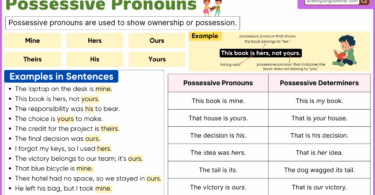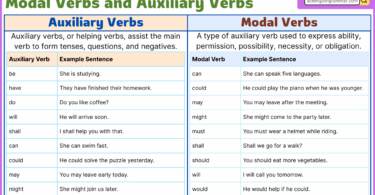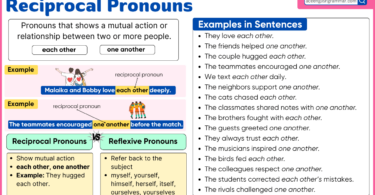Many English learners find it difficult to tell the difference between verbs that need an object and those that don’t. Understanding transitive and intransitive verbs is essential for building correct sentence structure. This blog post helps learn the definitions, key rules, and provides a useful list with examples for both verb types.
Table of Contents
What is a transitive verb?
A transitive verb is a verb that requires a direct object to complete its meaning. The action passes from the subject to the object.
- Hamza reads a book.
(“Reads” is transitive—“a book” is the object receiving the action.)
Examples of Transitive Verbs in Sentences
- She reads a book.
- They eat pizza for dinner.
- He paints a beautiful picture.
- We watch a movie on the weekend.
- He fixes his bicycle.
- I bought a new shirt.
- They visit the zoo on Saturdays.
- Mom makes a tasty sandwich.
- We plant flowers in the garden.
- The teacher explains the lesson.
- They open the gift with excitement.
- She answers the phone.
- She reads the newspaper in the morning.
- We clean the dishes after dinner.
- I write my homework in my notebook.
- They water the plants in the garden.
- She watches the birds in the park.
List of Transitive Verbs
- Eat
- Read
- Write
- Kick
- Love
- Paint
- Build
- Throw
- Watch
- Cook
- Clean
- Drive
- Teach
- Complete
- Sing
- Explain
- Understand
- Call
- Help
- Pass
- Finish
- Describe
- Carry
- Play
- Send
- Open
- Close
- Break
What is an intransitive verb?
An intransitive verb is a verb that does not take a direct object. The action stays with the subject or is followed by an adverb or complement—not a noun receiving the action.
- Fatima sleeps peacefully.
(“Sleeps” is intransitive—there’s no object receiving the action.)
What Does “Taking a Direct Object” Mean?
“Taking a direct object” means that a verb requires something or someone to receive the action of the verb. A direct object answers the question “what?” or “whom?” after the verb.
He kicked the ball.
→ Verb: kicked
→ What did he kick? → the ball = direct objectFatima reads a book.
→ What does she read? → a book = direct object
Examples of Intransitive Verbs in Sentences
- She laughs at jokes.
- The sun shines brightly.
- They swim in the pool.
- The flowers bloom in the spring.
- He runs every morning.
- The wind blows gently.
- The rain falls heavily.
- I sleep peacefully at night.
- The river flows steadily.
- The clock ticks loudly.
- The leaves fall in autumn.
- The old man walks slowly.
- The balloon floats in the air.
- The train arrives on time.
- The dog barks loudly.
- The clouds gather in the sky.
List of Intransitive Verbs
- Arrive
- Sleep
- Laugh
- Run
- Swim
- Jump
- Walk
- Relax
- Appear
- Disappear
- Breathe
- Die
- Cry
- Exist
- Occur
- Depart
- Drive
- Fly
- Float
- Gather
- Happen
- Sing
- Rise
- Set
- Shine
- Talk
- Wait
- Listen
- Speak
- Wander
- Arrive
- Belong
- Disagree
- Vary
- Develop
Some Verbs can be both Transitive and Intransitive
Many verbs can be considered both transitive and intransitive. The presence or absence of a direct or indirect object indicates whether a verb is transitive or intransitive.
For example:
- Transitive: “She read a book.” (Object: a book)
- Intransitive: “She reads” (No object)
- Transitive: “He broke the glass.” (Object: the glass)
- Intransitive: “The glass broke.” (No object)
Difference Between transitive and intransitive Verbs
| Aspect | Transitive Verbs | Intransitive Verbs |
| Definition | Verbs that require an object | Verbs that don’t require an object |
| Examples | I eat apples. | She sleeps. |
| Action | These verbs perform an action that affects an object. | These verbs describe actions without affecting an object. |
| Objects | They have a direct object that receives the action. | They do not have a direct object. |
| Completeness | Transitive verbs often feel incomplete without an object. | Intransitive verbs often feel complete on their own. |
| Questions | They often answers the question “what” or “whom.” | They typically answer “how,” “when,” or “where.” |
| Passive Voice | Can be turned into the passive voice. | Cannot be easily turned into a passive voice. |
| Sentences | Often used to construct more complex sentences. | Typically used in simpler sentences. |
| Meaning | Generally, they express what the subject does to an object. | Generally, they express what the subject does without affecting an object. |
| Follow | Followed by a direct or indirect object | Often followed by prepositions or adverbs |
Transitive and intransitive verbs exercise
Q1. Which of the following is a transitive verb?
- Sleep
- Run
- Eat
- Laugh
Q2. Which of the following is an intransitive verb?
- Write
- Arrive
- Read
- Cook
Q3. Identify the intransitive verb in the following sentence: “She wrote a beautiful poem.”
- She
- wrote
- a beautiful
- poem
Q4. Choose the intransitive verb in the sentence: “The cat jumped onto the table.”
- cat
- jumped
- onto
- table
Q5. Which of the following sentences contains a transitive verb?
- She sings beautifully.
- He reads a novel.
- They laugh together.
- The cat sleeps peacefully.
Q6. In the sentence, “She painted a beautiful picture,” what is the transitive verb?
- She
- painted
- beautiful
- picture
Q7. In the sentence, “They love chocolate,” what is the transitive verb?
- They
- love
- Chocolate
- They and love
Answers:
- c) Eat
- b) Arrive
- b) wrote
- b) jumped
- b) He reads a novel.
- b) painted
- b) love
Why Transitive and Intransitive Verbs Are Important
Understanding transitive and intransitive verbs is essential for mastering sentence structure and grammar in English. These two verb types help you:
Identify sentence patterns: Knowing whether a verb needs a direct object (transitive) or stands alone (intransitive) clarifies how sentences should be formed.
Avoid common grammar errors: Misusing these verbs can lead to incomplete or confusing sentences.
Improve communication skills: You’ll express ideas more clearly and accurately when you know how your verbs function.
Build strong writing: Proper use of both types helps in crafting well-structured, meaningful, and grammatically correct sentences.
FAQs
The main difference is that transitive verbs require a direct object to complete their meaning, while intransitive verbs do not require a direct object.
You can identify a transitive verb by asking the question “What?” or “Whom?” after the verb. If you get an answer, it’s likely a transitive verb. For example, in “She eats apples,” you can ask, “She eats what?” The answer is “apples,” so “eats” is a transitive verb.
Intransitive verbs typically do not have a direct object, so if you can’t ask “What?” or “Whom?” after the verb and get a meaningful answer, it’s likely an intransitive verb. For example, in “He sleeps,” if you ask, “He sleeps what?” there is no meaningful answer, indicating “sleeps” is an intransitive verb.
Yes, some verbs can be used as both transitive and intransitive, depending on the context. For example, “run” can be used intransitively (He runs) or transitively (He runs a race).
She slept peacefully. (Intransitive)
She read a storybook. (Transitive)
The leaves fall in the autumn. (Intransitive)
He sent an email to his boss. (Transitive)
He runs every morning. (Intransitive)
The sun shines brightly. (Intransitive)
Read More




Leave a Comment